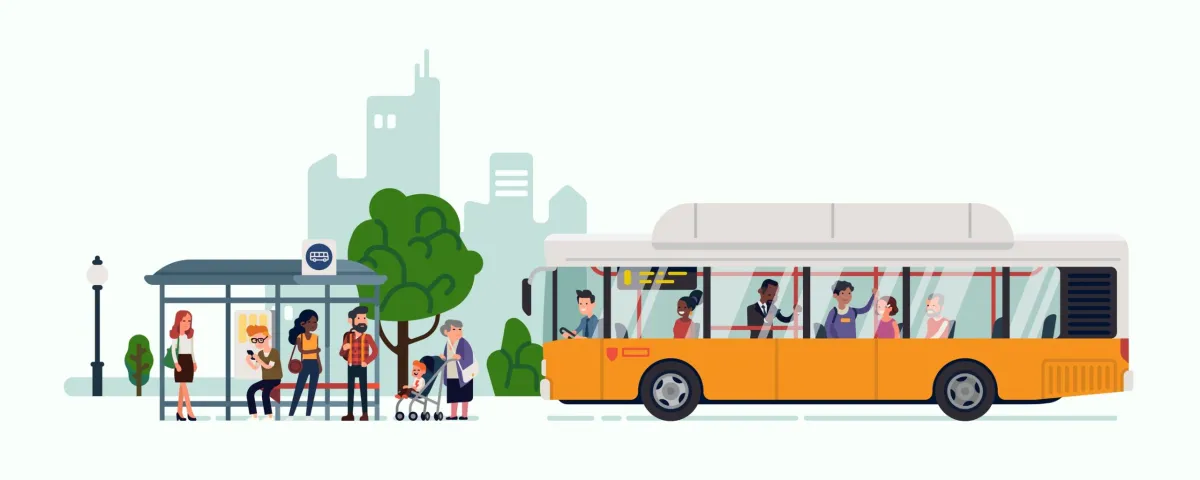Public Transit
Public transit systems are essential for reducing greenhouse gas emissions, alleviating traffic congestion, and improving air quality. Innovations such as electric buses, solar-powered trains, and wind-powered ferries are making public transit more sustainable.

Public Transit (Calmatters)
View open jobs in this Solution
Example Organizations
- Urent - Urent is an e-scooter and bike-sharing service provider of e-scooter and bikes for public transportation and urban mobility.
- Maas Global - MaaS Global is a mobility-as-a-service operator that provides its users all types of city transport services in a single app.
- BYD - World's largest manufacturer of electric vehicles, including electric buses.
- Bombardier - Leading manufacturer of trains and rail equipment.
- Siemens Mobility - Develops sustainable public transit solutions.
- Proterra - Specializes in electric buses and charging systems.
- New Flyer - North America's largest transit bus manufacturer.
Overview
In recent years, there has been a concerted effort to develop public transit systems that are more sustainable and have a smaller carbon footprint. This has led to the development of new technologies, including electric buses, solar-powered trains, and wind-powered ferries. These innovations have contributed to a significant reduction in greenhouse gas emissions from public transit systems around the world.
The biggest benchmark from Speed & Scale
By 2030, transition all new bus sales to zero-emission vehicles.
Use their news tracking tool to track progress
Progress Made
Significant advancements have been made in public transit technologies:
- Electric Buses: Reduced emissions and lower operating costs compared to diesel buses.
- Solar-Powered Trains: Utilizing solar panels to power trains and reduce reliance on fossil fuels.
- Wind-Powered Ferries: Harnessing wind energy to power ferries, reducing maritime emissions.
Solutions by Sector
Urban Transit
- Electric Buses: Zero-emission buses for city transit systems.
- Light Rail: Electrified rail systems for urban transportation.
- Bike-Sharing Programs: Providing an eco-friendly alternative for short-distance travel.
Case Studies:
- Los Angeles Metro, USA: Transitioning to a fully electric bus fleet by 2030 (LA Metro). While ambitious, the high upfront costs and infrastructure needs pose challenges.
- Copenhagen Metro, Denmark: Solar-powered trains reducing the city's carbon footprint (Copenhagen Metro). The integration of renewable energy sources is commendable but requires continuous investment.
- New York City Bike-Share Program, USA: Extensive bike-sharing network reducing traffic congestion and emissions (Citi Bike). However, the program faces challenges related to bike maintenance and user safety.
Intercity Transit
- High-Speed Rail: Electrified trains for long-distance travel.
- Regional Buses: Electric and hybrid buses for regional transportation.
- Ferry Services: Wind and solar-powered ferries for intercity travel.
Case Studies:
- California High-Speed Rail, USA: Aiming to connect major cities with zero-emission trains (California High-Speed Rail Authority). The project faces significant financial and political hurdles.
- FlixBus, Europe: Expanding electric and hybrid bus services across Europe (FlixBus). The scalability of electric buses for long-distance travel remains a challenge.
- Scandlines, Denmark-Germany: Operating hybrid ferries powered by wind and solar energy (Scandlines). The integration of renewable energy sources in maritime transport is promising but requires further innovation.
Technological Innovations
- Autonomous Vehicles: Self-driving buses and shuttles for public transit.
- Smart Transit Systems: Using data and AI to optimize transit routes and schedules.
- Energy Storage: Advanced batteries and energy storage solutions for public transit.
Case Studies:
- Waymo, USA: Developing autonomous vehicles for public transit (Waymo). The technology is promising but faces regulatory and safety challenges.
- Siemens Mobility, Germany: Implementing smart transit systems to improve efficiency (Siemens Mobility). The integration of AI and data analytics is beneficial but requires significant investment.
- Proterra, USA: Producing advanced batteries for electric buses (Proterra). The company faces competition and the need for continuous innovation.
Lessons Learned
-
Successes:
- Public transit systems have significantly reduced pollution and greenhouse gas emissions.
- Public transit can reduce traffic congestion and improve air quality.
- Investment in public transit infrastructure is crucial for long-term sustainability.
-
Failures:
- High costs and maintenance expenses hinder the expansion of public transit systems.
- Public transit can be unreliable, leading to decreased ridership.
- Some public transit projects face significant financial and political hurdles.
-
Lessons Learned:
- Investing in public transit infrastructure is essential for reducing emissions and improving efficiency.
- Community involvement and public awareness are crucial for successful public transit projects.
- Continuous research and development are needed to improve public transit technologies.
Challenges Ahead
- High Initial Costs: Building and maintaining public transit systems are expensive.
- Infrastructure Needs: Developing the necessary infrastructure to support public transit.
- Public Acceptance: Addressing concerns about reliability, safety, and convenience.
- Political Will: Securing political support and funding for public transit projects.
Best Path Forward
- Policy Support: Implement policies and regulations that incentivize the use of public transit.
- Financial Incentives: Provide financial incentives to encourage the adoption of public transit.
- Research and Development: Invest in R&D to improve public transit technologies.
- Public Engagement: Increase awareness and involvement of local communities in public transit projects.
- Collaboration: Foster partnerships between governments, companies, and organizations to support public transit development.
Prominent supporters include the American Public Transportation Association and the Transit Center.
Image credit: Calmatters